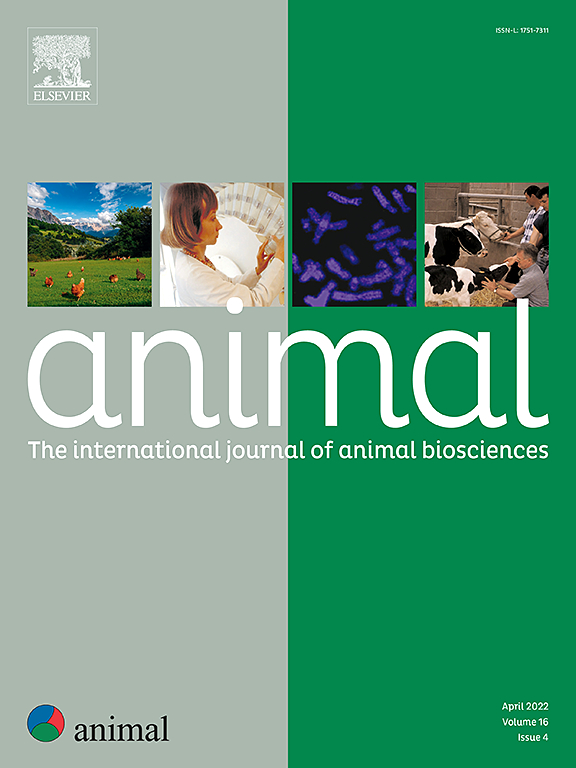Effects of dietary energy levels on production and absorption of hindgut short-chain fatty acids in two sheep breeds
IF 4
2区 农林科学
Q1 AGRICULTURE, DAIRY & ANIMAL SCIENCE
引用次数: 0
Abstract
Hindgut fermentation is a crucial process in the production of short-chain fatty acids (SCFAs) and the provision of energy for ruminants. However, hindgut fermentation is not well−researched and has only recently received more attention. Tibetan sheep (T-sheep), an indigenous sheep breed raised on the Qinghai-Tibetan Plateau (QTP), play a vital role in the livelihood of the residents and in ecosystem services in the region. They have adapted well to the fluctuating supply of energy and nutrition under the harsh environment of the QTP. As part of the same study as the present study, T-sheep produced more ruminal SCFAs and had a greater capacity to absorb SCFAs than Small-tailed Han sheep (H-sheep), a breed introduced to the QTP due to their high reproductive rate. These findings raised intriguing questions about whether T-sheep also produce and absorb a greater amount of hindgut SCFAs to adapt to the harsh QTP environment, and whether there is a link between rumen and hindgut dietary digestion. Twenty-four T-sheep and 24 H-sheep, all 1.5-year-old wethers, were divided randomly into four groups of six sheep in each breed, and each group received a diet of different energy yield, namely, 8.21, 9.33, 10.45 or 11.57 MJ digestible energy (DE)/kg DM. After 49 days of treatment, all sheep were slaughtered, and tissues and digesta from the cecum, colon, and rectum were collected. The morphology of tissues was examined, and the concentrations of SCFAs in digesta and the expressions of related genes involved in the absorption and metabolism of SCFAs were determined. The concentration of total SCFAs and the molar proportion of butyrate increased in each site as the dietary energy level increased, and the H-sheep produced greater yields of total SCFAs in both the colon and rectum than T-sheep. This indicated a greater production of SCFAs in the hindgut of H-sheep than T-sheep, compensating for their lesser production in the rumen. T-sheep had a greater absorption surface area of the hindgut and greater mRNA expressions of SCFA transporters, indicating a greater capacity to absorb SCFAs than H-sheep. However, T-sheep had lesser mRNA expressions of the rate-limiting enzymes and regulators in SCFAs metabolism, indicating a lesser capacity for metabolism of SCFAs in the hindgut than H-sheep. These characteristics confer T-sheep with an advantage in the absorption and metabolism of SCFAs in the hindgut, enabling them to adapt rapidly to the highly fluctuating energy intake on the harsh QTP.
求助全文
约1分钟内获得全文
求助全文
来源期刊

Animal
农林科学-奶制品与动物科学
CiteScore
7.50
自引率
2.80%
发文量
246
审稿时长
3 months
期刊介绍:
Editorial board
animal attracts the best research in animal biology and animal systems from across the spectrum of the agricultural, biomedical, and environmental sciences. It is the central element in an exciting collaboration between the British Society of Animal Science (BSAS), Institut National de la Recherche Agronomique (INRA) and the European Federation of Animal Science (EAAP) and represents a merging of three scientific journals: Animal Science; Animal Research; Reproduction, Nutrition, Development. animal publishes original cutting-edge research, ''hot'' topics and horizon-scanning reviews on animal-related aspects of the life sciences at the molecular, cellular, organ, whole animal and production system levels. The main subject areas include: breeding and genetics; nutrition; physiology and functional biology of systems; behaviour, health and welfare; farming systems, environmental impact and climate change; product quality, human health and well-being. Animal models and papers dealing with the integration of research between these topics and their impact on the environment and people are particularly welcome.
 求助内容:
求助内容: 应助结果提醒方式:
应助结果提醒方式:


